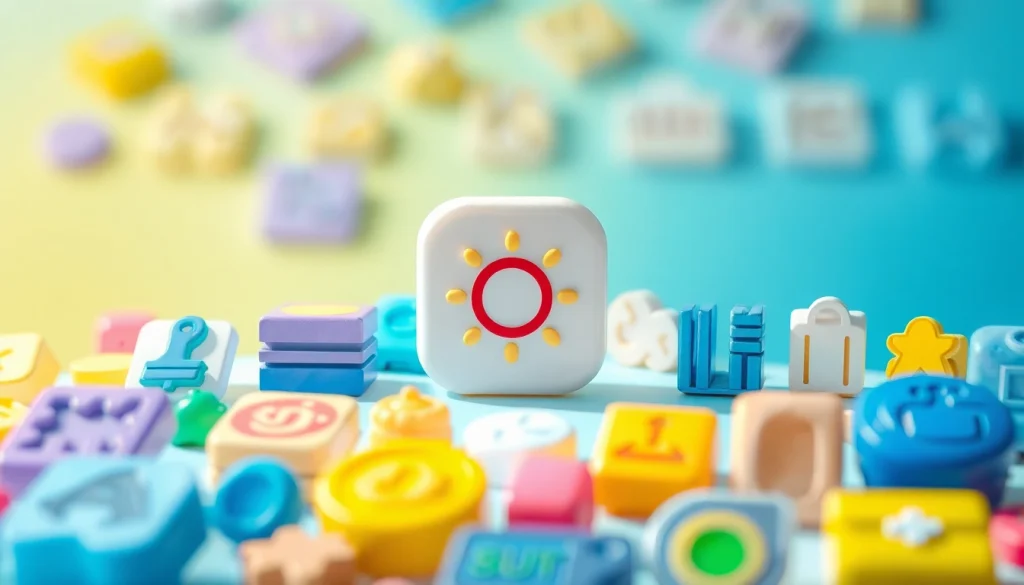Unlocking the Power of Icons: Elevate Your Design Projects

Understanding Icons: Their Importance and Usage
What Are Icons and Why They Matter
Icons are visual representations used to convey information or represent an action, idea, or object in a simplified manner. They are crucial in our contemporary digital landscape, serving as a bridge between language and visual communication. Icons accompany text to enhance the user experience, making it easier for individuals to navigate and interact with software, websites, and applications. Their importance lies in their ability to communicate complex ideas quickly and efficiently without resorting to lengthy explanations.
In fields like graphic design, user interface design, and web development, icons are indispensable. They allow designers to present key functionalities and concepts, ensuring that users can identify features seamlessly. The effectiveness of an icon is often measured by its recognizability and the emotional response it elicits, making the study of iconography a fascinating venture into human psychology and cultural representation.
The Role of Icons in Design Communication
In design communication, icons serve various fundamental purposes. Firstly, they enhance clarity by breaking down information into digestible pieces. An intuitive icon can guide users more effectively than a series of text descriptions, facilitating a smoother user journey. For instance, universally recognized symbols like the trash can for delete or the magnifying glass for search transcend language barriers and foster inclusivity.
Moreover, icons embellish visual hierarchy within a design, directing attention to essential features and functionalities. In user interfaces, the strategic placement of icons can improve usability and reduce cognitive load through visual cues, helping users perform tasks more efficiently.
Common Types of Icons and Their Applications
Icons can be categorized into several types based on their design and function. Here are some common examples:
- Action Icons: Icons that represent specific actions users can take, such as download, share, or print.
- Navigation Icons: Used to help users find their way around a website or app (e.g., home, back, settings).
- Social Media Icons: Icons representing various social media platforms that facilitate sharing and connecting (e.g., Facebook, Twitter, Instagram).
- Brand Icons: Distinctive symbols that represent brands or companies, aiding in recognition and recall.
- Indicator Icons: Visual elements that provide feedback or status, such as notifications or loading symbols.
Designing Effective Icons
How to Choose the Right Style for Your Icons
Selecting the right icon style is paramount for effective design. Considerations include the overall aesthetic of the platform, target audience, and the specific message the icons must convey. Popular styles vary from flat icons that promote minimalism to 3D icons that provide depth and realism. For instance, a tech company may opt for sleek, modern icons reflecting innovation, whereas a friendly app for children might use colorful, cartoonish icons to engage younger users.
Best Practices for Icon Design
Designing effective icons requires adherence to several best practices:
- Simplicity: Icons should be simple and easily recognizable. Avoid excessive details that can confuse users.
- Consistency: Maintain a consistent design language across all icons to ensure a cohesive look and feel.
- Scalability: Icons should be scalable without losing clarity, ensuring they remain effective on various screen sizes.
- Functional Relevance: Design icons that accurately convey their intended function to enhance user understanding.
- Color Usage: Utilize color strategically to evoke emotions or signify actions, but ensure accessibility for color-blind users.
Tools and Software for Creating Icons
A range of design tools is available for icon creation, catering to various skill levels. Some popular icon designing software includes:
- Adobe Illustrator: A professional vector graphics editor offering extensive tools and resources for icon design.
- Sketch: A design tool favored among UI/UX designers, featuring intuitive interface capabilities ideal for icon creation.
- Figma: A cloud-based interface design tool that allows real-time collaboration, suitable for teams working on icon sets.
- Inkscape: A free, open-source vector graphics editor that provides a viable option for creating icons on a budget.
- Affinity Designer: A cost-effective alternative to Illustrator with powerful tools for icon design.
Icon Trends: Staying Current in a Changing Landscape
Emerging Styles and Techniques in Icon Design
The world of icon design is continually evolving, with new trends emerging with changes in technology and design philosophy. Some of the most notable trends include:
- Line Icons: Also known as outline icons, these designs favor simplicity and elegance, often favored for their minimalist aesthetic.
- Duotone and Gradient Icons: Incorporating gradients gives icons a modern twist while adding depth and dimension.
- Custom Illustrations: Brands are investing in unique iconography that reflects their personality, leading to distinctive visual identities.
- Microinteractions: Interactive icons that respond to user actions, providing feedback and enhancing engagement.
- 3D Icons: With advancements in design software, 3D icons are gaining popularity due to their visual appeal and enhanced realism.
Case Studies: Innovative Use of Icons in Design
Several organizations have creatively utilized icons to enhance user experience. Here are a few examples:
- Airbnb: The travel platform uses unique, custom icons that reflect local experiences, improving user engagement by connecting emotionally with users.
- Slack: Slack utilizes playful, imaginative icons that represent their features, adding a touch of personality and reducing intimidation for new users in a complex workspace.
- Trello: Trello incorporates icons that visually represent task categories, facilitating easier navigation and improved usability in project management.
Guidelines for Adapting to New Icon Trends
Adapting to design trends requires a thoughtful approach. Here are some guidelines:
- Research and Feedback: Before implementing new styles, conduct research and gather feedback from users to ensure designs resonate with your audience.
- Test for Usability: Evaluate how new icons integrate into your user interface. Conduct usability tests to gauge user preferences and effectiveness.
- Stay Flexible: Design quality should remain paramount. Balancing trendiness with utility is crucial, ensuring that icons serve their intended purpose.
Icons in User Interface Design
Integrating Icons into User Experiences
Icons should be seamlessly integrated into user experiences to enhance functionality and aesthetics. When designing user interfaces, consider the following:
- Logical Placement: Place icons in contexts where users expect to see them, maintaining a clear architecture of information and action.
- Label Icons: Use text labels alongside icons in critical functions to alleviate confusion and reinforce their meanings.
- Visual Feedback: Icons should provide visual feedback upon interaction, indicating success, error, or loading states to keep users informed.
Accessibility Considerations for Icon Usage
Designing accessible icons is essential in an inclusive digital environment. Ensure icons are designed with considerations for:
- Color Contrast: Maintain sufficient contrast levels between icons and backgrounds for visibility, accommodating users with visual impairments.
- Alternative Text: Always include descriptive alt text for icons to assist visually impaired users who rely on screen readers.
- Scalable Designs: Icons should be legible at both small and large sizes, allowing users to interact comfortably.
Testing Icons for User Engagement and Performance
User engagement can be significantly influenced by the quality of icon design. Implement testing measures, such as A/B testing, to evaluate how modifications to icon design impact user behavior and performance metrics. Track metrics like click-through rates, time spent on tasks, and user satisfaction to identify successful designs.
Future of Icons: What Lies Ahead
Predictions for Icon Design in the Next Decade
The future of icon design is promising, with several exciting trends on the horizon. We can expect greater interactivity within icons, where they not only serve as static indicators but also enhance user experiences through mini-animation or subtle transitions. Additionally, as augmented and virtual reality technologies advance, icons will likely evolve to fit immersive environments, making them even more integral to user navigation.
The Impact of Emerging Technologies on Icons
Emerging technologies such as artificial intelligence and machine learning are set to impact how icons are designed and utilized. AI can automate the creation of icons based on user data or preferences, producing personalized icon sets for different demographics. Furthermore, as voice interfaces become more prevalent, the traditional role of icons may change, emphasizing the need for adaptable designs that can transition between visual and auditory cues.
Innovative Ideas for the Next Generation of Icons
As we look ahead, we can anticipate icons evolving into more complex visual elements. Innovations might include contextual icons that adjust their appearance based on user interactions or environmental variables. Moreover, the intersection of augmented reality and iconography could pave the way for entirely new experiences where icons become dynamic components of our surroundings.







